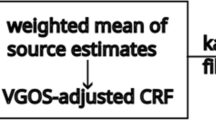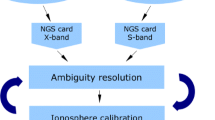Abstract
We present a Kalman filter for combining dUT1 from the VLBI Intensive sessions with GNSS results for rapid estimation of dUT1. In order to be able to also combine polar motion, pre-reduced normal equations for the Intensive sessions are used in the Kalman filter. We validate our results by comparing with dUT1 estimates from standard global 24-h VLBI sessions. It is found that the Kalman filter is able to use the polar motion measured by GNSS to properly correct the errors in dUT1 caused by inaccurate a priori polar motion. Furthermore, we investigate how the coordinates of the Tsukuba VLBI station can be handled in the analysis after the Tōhoku (Japan) Earthquake in 2011.
Access this chapter
Tax calculation will be finalised at checkout
Purchases are for personal use only
Similar content being viewed by others
References
Bizouard C, Gambis D (2009) The combined solution C04 for Earth orientation parameters consistent with international terrestrial reference frame 2005. In: Geodetic reference frames, IAG symposium, vol 134. Springer, Munich, pp 265–270. doi:10.1007/978-3-642-00860-3_41
Böhm J, Böhm S, Nilsson T, Pany A, Plank L, Spicakova H, Teke K, Schuh H (2012) The new Vienna VLBI software. In: Kenyon S, Pacino MC, Marti U (eds) IAG scientific assembly 2009 (no. 136 in international association of geodesy symposia). Springer, Buenos Aires, pp 1007–1011. doi:10.1007/978-3-642-20338-1_126
Brown RG, Hwang PYC (1997) Introduction to random signals and applied Kalman filtering, 3rd edn. Wiley, London
Dow JM, Neilan RE, Rizos C (2009) The international GNSS service in a changing landscape of global navigation satellite systems. J Geodesy 83:191–198. doi:10.1007/s00190-008-0300-3
Freedman AP, Steppe JA, Dickey JO, Eubanks TM, Sung LY (1994) The short-term prediction of universal time and length of day using atmospheric angular momentum. J Geophys Res 99(B4):6981–6996. doi:10.1029/93JB02976
Morabito DD, Eubanks TM, Steppe JA (1988) Kalman filtering of earth orientation changes. In: Babcock A, Wilkins GA (eds) The Earth’s rotation and reference frames for geodesy and geodynamics. Reidel, Dordrecht/Holland, pp 257–267
Nilsson T, Böhm J, Schuh H (2011) Universal time from VLBI single-baseline observations during CONT08. J Geodesy 85(7):415–423. doi:10.1007/s00190-010-0436-9
Nilsson T, Böhm J, Schuh H, Schreiber U, Gebauer A, Klügel T (2012) Combining VLBI and ring laser observations for determination of high frequency Earth rotation variation. J Geodyn 62:69–73. doi:10.1016/j.jog.2012.02.002
Nothnagel A, Schnell D (2008) The impact of errors in polar motion and nutation on UT1 determinations from VLBI intensive observations. J Geodesy 82:863–869. doi:10.1007/s00190-008-0212-2
Robertson DS, Carter WE, Campbell J, Schuh H (1985) Daily Earth rotation determinations from IRIS very long baseline interferometry. Nature 316:424–427
Schuh H, Behrend D (2012) VLBI: A fascinating technique for geodesy and astrometry. J Geodyn 61:68–80. doi:10.1016/j.jog.2012.07.007
Sekido M, Takiguchi H, Koyama Y, Kondo T, Haas R, Wagner J, Ritakari J, Kurihara S, Kokado K (2008) Ultra-rapid UT1 measurement by e-VLBI. Earth Planets Space 60:865–870
Senior K, Kouba J, Ray J (2010) Status and prospects for combined GPS LOD and VLBI UT1 measurements. Artif Satell 45(2):57–73. doi:10.2478/v10018-010-0006-7
Thaller D, Tesmer V, Dach R, Krügel M, Rothacher M, Steigenberger P (2008) Combining VLBI intensive with GPS rapid solutions for deriving a stable UT time series. In: Finkelstein A, Behrend D (eds) Proceedings of the fifth IVS general meeting: measuring the future, pp 8–13. http://ivscc.gsfc.nasa.gov/publications/gm2008/
Acknowledgements
We are grateful to the VLBI stations contribution to the Intensives and to the International VLBI Service for Geodesy and Astrometry (Schuh and Behrend 2012) for providing the data. This work was supported by the Austrian science fund (FWF), project number P24187-N21.
Author information
Authors and Affiliations
Corresponding author
Editor information
Editors and Affiliations
Rights and permissions
Copyright information
© 2015 Springer International Publishing Switzerland
About this paper
Cite this paper
Nilsson, T. et al. (2015). Rapid UT1 Estimation by Combining VLBI Intensives with GNSS. In: Rizos, C., Willis, P. (eds) IAG 150 Years. International Association of Geodesy Symposia, vol 143. Springer, Cham. https://doi.org/10.1007/1345_2015_105
Download citation
DOI: https://doi.org/10.1007/1345_2015_105
Published:
Publisher Name: Springer, Cham
Print ISBN: 978-3-319-24603-1
Online ISBN: 978-3-319-30895-1
eBook Packages: Earth and Environmental ScienceEarth and Environmental Science (R0)




